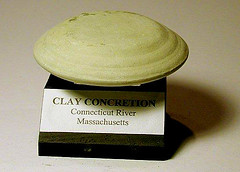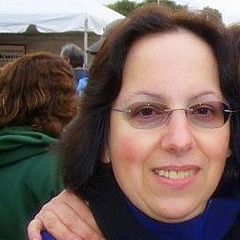What Did Native Americans Once Call Connecticut River Clay Concretions?
Massachusetts Treasures:
Famous Formations: Clay Concretions
By HF Guest Blogger, Maria Sansalone
 Thanks again to everyone who participated in the Connecticut Valley Mineral Club’s geology contest! To answer our last contest question, read the following carefully:
Thanks again to everyone who participated in the Connecticut Valley Mineral Club’s geology contest! To answer our last contest question, read the following carefully:
Clay Concretions are flat, usually round discs of clay and silt that formed underwater along the Connecticut River. These formations are not as old as some mineral occurrences in the area. Still, they are estimated to be over 10,000 years old. Native Americans who lived close to the Connecticut River in Hampshire County called them “puddle stones” and could very well have used them as money or as jewelry for ceremonies. No one is quite sure how these discs get their almost perfect round and layered shape, but some believe that the mud and clay were spun in a circular motion by moving water, building up layers of clay silt that, over thousands of years, have hardened them into the discs we find today. The Hadley and Hatfield areas of Massachusetts are known for having some of the nicest Concretions in the country. The discs can range in size from 1 inch to 4 or 5 inches across and are regularly sought by divers and collectors today.
WEEK THREE CONTEST QUESTION
Here is our third and final contest question, good for two free adult admissions to the “Western Mass. Mineral, Jewelry, and Fossil Show,” on March 26 and 27, 2011: What name did Native Americans once give to Connecticut River Clay Concretions?
Deadline to enter to win is Thursday, March 24th at 7pm (EST). Must include full name, town and an accurate email address in the comment fields below to be eligible to win. Name of winner will be posted below with directions on how to claim your tickets.
FIELD TRIP TIPS
Unless you are a professional diver and collector, it would be impossible for you and me to take a collecting field trip for Concretions into the swift cold waters of the Connecticut River! The next time your family takes a trip to a lake or hikes the New England woods, be sure to search for pegmatite, a type of rock that often contains crystal formations, or look for splashes of color in rocks as you walk. And (carefully) check pockets around tree roots. Rocks and fossils and minerals gather in tree roots and are buried or washed away by water every day. Or, consider taking a “virtual” field trip! There are a number of western Massachusetts and global geological formations that are accessible online as “dynamic digital maps,” created by researchers from the University of Massachusetts. Your next field trip leaves now at this web link: ddm.geo.umass.edu.
For our last blog post, we’ve included an enlarged photo of a (very, very old) Clay Concretion from our Club’s Massachusetts Mineral School Display Kit.
Best wishes to all our contest participants! It’s a bit sad to think that this is our Club’s final post and contest question! But we hope it doesn’t mean the end to your interest in fossils, rocks, and minerals. There’s a whole world of adventure out there, just waiting for you to discover…
The Connecticut Valley Mineral Club promotes responsible rockhunting. Always ask permission to walk private lands and take only photographs, not samples, of protected geological formations. CVMC meets most months at the Springfield Science Museum in Springfield, Massachusetts. For more information, feel free to visit our website: www.cvmineralclub.org.
ABOUT THE AUTHOR
Maria works as the primary cross-reference editor for Merriam-Webster Inc., in Springfield, Massachusetts. She and her team have cross-reference checked every dictionary entry for the last two editions of Merriam-Webster’s Collegiate Dictionary. Her personal life revolves around the work that she does in memory of her son, William, for two family-oriented nonprofits in western Massachusetts: Griffin’s Friends Children’s Cancer Fund at Baystate Children’s Hospital, and the Connecticut Valley Mineral Club. It was the desire to learn from experienced collectors about New England’s minerals on behalf of kids on treatment that led her and her husband to join the CVMC community.
 Hilltown Families
Hilltown Families 
 Maria Sansalone
Maria Sansalone




























Found these 100 feet below the earth excavating near UMass.
Congratulations, Jenni! You have won two free adult tickets to the show.
Puddlestones! Very interesting – I’d love to take my daughter to the show. Thanks!
Jenni Haley
Sunderland, MA
Contestants are welcome to post responses here for this last question, good for two free adult admissions into CVMC’s “Western Mass. Mineral, Jewelry, and Fossil Show”! Our Show Event runs both Saturday, March 26 and Sunday, March 27, at the Holiday Inn at Ingleside; see our Club’s exhibits and demonstrations, join us (kids 12 and under are free) for an hour, the afternoon, or all day if you like!